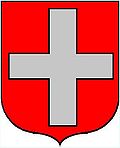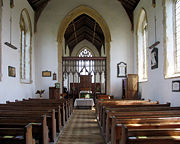
De Walcott family
Encyclopedia

Lord of the Manor
The Lordship of a Manor is recognised today in England and Wales as a form of property and one of three elements of a manor that may exist separately or be combined and may be held in moieties...
of Walcott
Walcott, Norfolk
Walcott is a small village and civil parish on the North Norfolk coast in England between Mundesley and Happisburgh.The name derives from the Celtic word Walecote, which means village by the wood. The village is north east of Norwich, south east of Cromer and north east of London...
from the late 12th century until the late 14th century.
This article is adapted from The Historic Happing Website with permission.
Manor houses

Chronology
The de Walcott family is first noted in East Hall in Walcott during the reign of Henry IIHenry II of England
Henry II ruled as King of England , Count of Anjou, Count of Maine, Duke of Normandy, Duke of Aquitaine, Duke of Gascony, Count of Nantes, Lord of Ireland and, at various times, controlled parts of Wales, Scotland and western France. Henry, the great-grandson of William the Conqueror, was the...
(1154 to 1189) when William de Edgefield was living when his mother, Maud de Walcott who granted two parts of the tithe
Tithe
A tithe is a one-tenth part of something, paid as a contribution to a religious organization or compulsory tax to government. Today, tithes are normally voluntary and paid in cash, cheques, or stocks, whereas historically tithes were required and paid in kind, such as agricultural products...
of her lands in Walcott to the monks of Bromholm Priory
Bromholm Priory
Bromholm Priory was a Cluniac priory, situated in a coastal location near the village of Bacton, Norfolk, EnglandBromholm Priory, also known as Bacton Abbey, was founded in 1113 by William de Glanville, Lord of Bacton, and was originally subordinate to Castle Acre Priory until 1195 when it was...
in Bacton
Bacton, Norfolk
Bacton is a village and civil parish in Norfolk, England. It is on the Norfolk coast, some 20 km south-east of Cromer, 40 km north-west of Great Yarmouth and 30 km north of Norwich. Besides the village of Bacton, the parish includes the nearby settlements of Bacton Green, Broomholm,...
.
Peter de Edgefield, father of William and his wife (Hawise) had a daughter (Letitia) who married Sir William de Rosceline and brought this manor into that family.
In 1240 and possibly 1281, Thomas de Walcott held part of the advowson
Advowson
Advowson is the right in English law of a patron to present or appoint a nominee to a vacant ecclesiastical benefice or church living, a process known as presentation. In effect this means the right to nominate a person to hold a church office in a parish...
(income) of Walcott church and was lord of West Hall in Walcott.
In 1286, Peter de Rosceline claimed wreck at sea and frankpledge
Frankpledge
Frankpledge, earlier known as frith-borh , was a system of joint suretyship common in England throughout the Early Middle Ages. The essential characteristic was the compulsory sharing of responsibility among persons connected through kinship, or some other kind of tie such as an oath of fealty to a...
, he and his wife were living in 1316. Their son, Sir Thomas de Roseceline inherited the manor afterwards.
In 1286, Sir Walter de Walcott held a moiety
Moiety title
Moiety title is legal term describing a portion other than a whole of ownership of property. The word derives from Old French moitié meaning "half" , from Latin medietas "middle", from medius....
in Hempstead and was patron
Patrón
Patrón is a luxury brand of tequila produced in Mexico and sold in hand-blown, individually numbered bottles.Made entirely from Blue Agave "piñas" , Patrón comes in five varieties: Silver, Añejo, Reposado, Gran Patrón Platinum and Gran Patrón Burdeos. Patrón also sells a tequila-coffee blend known...
of Wallington
Wallington
Wallington is the name of a number of places:In the UK:* Wallington, Hampshire* Wallington, Hertfordshire* Wallington, London, a town in the London Borough of Sutton* Wallingtons, a manor house in Kintbury, Berkshire, now the St Cassian's Centre...
in 1302. Walter was married to Lucia.
In 1286, Alexander de Walcott, son of Walter de Walcott, and his brother Thomas had 16 messuages, 120 acre (0.4856232 km²) of land, 12 acres (48,562.3 m²) of pasture, 31 acres (125,452.7 m²) of wood in Eccles, Hempstead, Palling and Stalham
Stalham
Stalham is a market town on the River Ant in the English county of Norfolk, in East Anglia. It covers an area of and had a population of 2,951 in 1,333 households as of the 2001 census. It lies within the Norfolk Broads, about north-east of Norwich on the A149 road.For the purposes of local...
.
Alexander de Walcott was lord of West Hall in 1302, a lord in Walcott in 1315, and in 1316 he and his wife (Maud) held West Hall.


There is confusion about whom Alexander de Walcott married. Francis Bloomfield states that in 1333 he was married to Joan and paid 15 marks to the King for an interest in Hempstead. However, he is also noted as being married to Maud and had four daughters called Cecilia, Elizabeth, Mariota and Margaret. Possibly he was married twice.
In 1340 Alexander de Walcott conveyed his right in West Hall in Walcott to Sir Walter de Walcott [A], his son Alexander de Walcott died in 1341.
Sir Walter de Walcott was a lord in Walcott in 1347 and in 1355 he presented to Walcott church.
In 1347 Simon de Walcott was presented to Walcott church by Thomas de Walcott, Rector of Felbrigg.
Walter married Millicent, daughter and heir of Walter de Gunton and held the manor of Gunton. Walter and Millicent had three daughters – one was Margaret, who married Thomas de Wymondham – and a son, also called Walter [B].
Sir Walter de Walcott died in 1355.
Sir Walter [B] de Walcott died in 1366. He was married to Joan, daughter of Walter de Clopton. Walter and Joan had four daughters: Elizabeth who married Ralph Bray of Wickhampton; Catherine who married John Durward; Margery a nun of Carrow Priory in Norwich; and Margaret who married Sir Robert Berney of Wickhampton and had the manor of Gunton.
There was a Sir Alexander de Walcott living around 1377, although what relation he was to the above is unknown. Walter Rye states that he was not the brother of Sir Walter de Walcott. Alexander probably married a daughter from the Westingthorpe family and had a daughter who married Andrew Brampton plus a son. This son had a son called John de Walcott of Wallington who had a daughter called Isabel who married Robert Brampton.
The last note of the family in Walcott was in 1377 with Sir Alexander de Walcott.
In 1378 William le Parker sold the manor of Brumstead
Brumstead
Brumstead is a village and a civil parish in the English county of Norfolk. The village is North East of Norwich, south south east of Cromer and north-east of London. The village lies north of the town of Stalham.The nearest railway station is at North Walsham for the Bittern Line which runs...
and the manor of Eccles to Simon de Walcote, Rector
Rector
The word rector has a number of different meanings; it is widely used to refer to an academic, religious or political administrator...
of Walcote.

